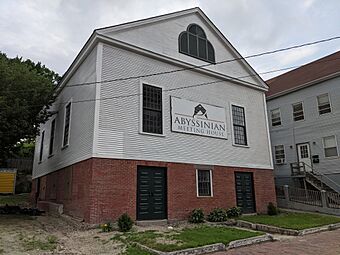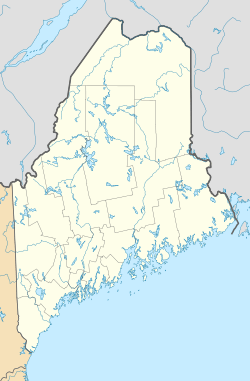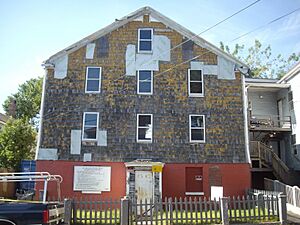Abyssinian Meeting House facts for kids
Quick facts for kids |
|
|
Abyssinian Meeting House
|
|
 |
|
| Location | 73–75 Newbury St., Portland, Maine |
|---|---|
| Area | less than one acre |
| Built | 1831 |
| Architectural style | Federal |
| NRHP reference No. | 05001612 |
| Added to NRHP | February 3, 2006 |
The Abyssinian Meeting House is a historic church building in the Munjoy Hill neighborhood of Portland, Maine. It was built between 1828 and 1831 by free African-Americans. It is the oldest church for African-Americans in Maine and the third-oldest in the entire country.
For many years, the Abyssinian was a center for worship, community meetings, and concerts. It was also a key location for the movement to end slavery. From the 1840s to the 1850s, it served as a school for Black children in Portland. The building is also the only site in Maine that the National Park Service officially recognizes as part of the Underground Railroad, a secret network that helped enslaved people escape to freedom.
Contents
A Place of Hope and Community
The Abyssinian Meeting House was the heart of the African-American community in southern Maine. It was created because Black residents of Portland wanted their own place to worship with dignity.
Why Was the Church Needed?
In the early 1800s, many churches were segregated. This meant that African-American members were treated unfairly. They were often forced to sit in balconies, away from white members, or were discouraged from coming to church at all.
In 1826, a group of Black leaders, including Christopher Christian Manuel and his brother-in-law Reuben Ruby, wrote a letter to a local newspaper. They spoke out against the poor treatment they received at the Second Congregational Church. Two years later, they officially formed the Abyssinian Religious Society to create their own church.
Building a Dream
Reuben Ruby (1798–1878) was a key figure in the church's creation. He was a respected businessman and a strong voice against slavery. He sold the land for the church to the Society in 1831 and helped build the inside of the meeting house.
Ruby was also a major part of the Maine Anti-Slavery Society. He used his carriage business to help transport people who had escaped from slavery. He even hosted famous abolitionist William Lloyd Garrison in his home.
The church was an active place of worship for 86 years, from 1831 to 1917. Over time, it was known by different names, like the Sumner Street Church and the Newbury Street Church, as the street it was on changed its name.
A Center for Freedom and Education
The Abyssinian was more than just a church. It was a safe place for people fighting for freedom and a school for children in the community.
A Stop on the Underground Railroad
The Reverend Amos Noé Freeman was the church's first full-time minister, serving from 1841 to 1851. He was a known agent on the Underground Railroad. He used the meeting house to organize anti-slavery events and to give a platform to people who had escaped slavery to share their stories.
A School for Black Children
In 1846, the school for African-American children in Portland moved into the Abyssinian's vestry (a room in the church). Reverend Freeman became the school's principal. Under his leadership, the school improved greatly, and students even began to receive music education. By 1851, about 55 students attended the school regularly. The school closed in 1856, and after that, African-American students in Portland attended integrated schools with white students.
The meeting house is also one of the few buildings in the area that survived the 1866 Great Fire of Portland, Maine. Local stories say that church members worked hard to protect their building from the flames.
Hard Times and a New Beginning
Over the years, the church faced many challenges. The number of members slowly went down as more churches opened in Portland and the city's African-American population spread out.
A terrible event in 1898 struck the community hard. The steamship SS Portland sank in a storm, and seventeen men from the church's congregation died. This was a huge loss for the church, and its activities were greatly reduced afterward.
In 1917, the state of Maine officially closed the church and sold the building. Most of the remaining members joined what is now the Green Memorial A.M.E. Zion Church. After it was sold, the Abyssinian building was used for many things, including a stable and an antique store. In 1924, it was turned into apartments. By 1991, the city of Portland took ownership of the building because taxes had not been paid.
Bringing History Back to Life
After being empty for six years, the building was purchased in 1998 by a group called the Committee to Restore the Abyssinian. Their goal was to save this important piece of history. The committee bought the building for $250, the same price the original Society paid for the land back in 1828.
The Abyssinian Meeting House was added to the National Register of Historic Places in 2006. A year later, it was recognized as part of the National Underground Railroad Network to Freedom.
Discoveries During Restoration
In 2008, archaeologists dug around the property to learn more about its past. They found amazing artifacts from the 1800s, including toys, slate pencils for writing, an inkwell, marbles, and pieces of dishes.
While working on the building, crews uncovered original wooden beams from the 1830s. They believe some of these beams were part of the choir loft. They also found an old wooden water pipe buried on the site, showing how people managed water in the area long ago.
In 2021, the project received a large grant of $375,000 to help pay for the building's restoration, ensuring that this historic landmark will be preserved for future generations to learn from and enjoy.
See also




